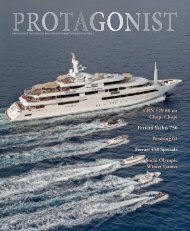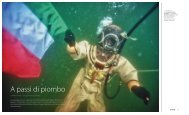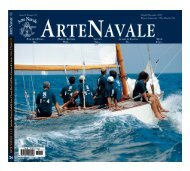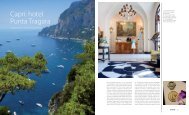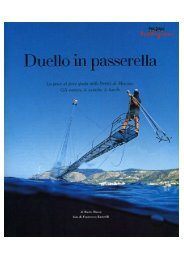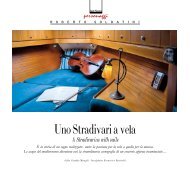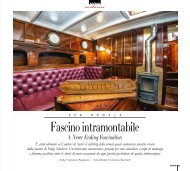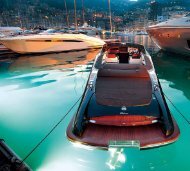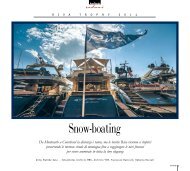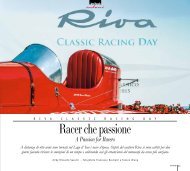SeaHome1_ArteNavale
You also want an ePaper? Increase the reach of your titles
YUMPU automatically turns print PDFs into web optimized ePapers that Google loves.
Arte Navale<br />
restauri<br />
G I O I E L L I D A S A L V A R E<br />
Una “casa al mare"<br />
A “home at sea"<br />
Varata nel 1919, la navetta in acciaio progettata e costruita dall’architetto svedese Hugo Shubert torna,<br />
a distanza di quasi un secolo, al suo antico splendore grazie al restauro filologico<br />
realizzato presso i Cantieri Navali di Sestri<br />
di/by Riccardo Sassòli - foto/photos Francesco Rastrelli<br />
85
Il restauro di una imbarcazione è<br />
sempre avvolto in un magico alone<br />
composto di artigianalità, desiderio,<br />
speranza, fiducia e soprattutto curiosità.<br />
Si attende con trepidazione la fine dei lavori,<br />
e questo non tanto per paura di una<br />
eccessiva durata, cosa che dipende soprattutto<br />
dalla capacità di programmazione<br />
del cantiere, ma per poter “godere” della<br />
propria imbarcazione nella quale viene<br />
immessa nuova linfa vitale. Sì perché, soprattutto<br />
quando si tratta di imbarcazioni<br />
ferme da molti anni, si desidera capire se la<br />
scelta fatta soddisfa appieno le aspettative.<br />
Nel caso di Sea Home il bellissimo cruiser<br />
dislocante presentato in queste pagine,<br />
anche il restauro stesso è stato immortalato<br />
nel migliore dei modi per entrare a far<br />
parte della storia di questo yacht a motore,<br />
con piccola vela ausiliaria, varato nel<br />
1919. Proprio di questo vorremo parlarvi,<br />
dell’importanza cioè di fissare al meglio il<br />
ricordo dello stato iniziale. Di solito queste<br />
immagini sono realizzate in tutta fretta e<br />
spesso, quando a lavori ultimati si decide<br />
di realizzare un bell’articolo, ci si ricorda<br />
di quegli scatti fatti quasi sempre con poca<br />
convinzione. Per Sea Home abbiamo voluto<br />
invece essere sicuri di poter conservare<br />
un bel ricordo del “punto di partenza”.<br />
Ecco quindi queste immagini, proposte<br />
in bianco e nero, per godere appieno del<br />
fascino dell’inizio del “work in progress”.<br />
Proprio questo stile consente di pulire le<br />
fotografie da quei colori “inquinanti”.<br />
Tinte non proprie della barca ma determinate<br />
dall’usura, dai materiali di lavoro<br />
e in generale da elementi esterni. Il B&W<br />
In apertura: la particolare poppa tipo<br />
norvegese del Sea Home.<br />
In questa pagina: la prua vista dalla<br />
deck, house e un particolare del teck<br />
completamente sostituito.<br />
On the opening page: the particular<br />
Norwegian-type stern of the Sea Home.<br />
On this page: the bow seen from the<br />
deckhouse and a detail of the teak that<br />
has been fully replaced.<br />
86
The restoration of a boat is always<br />
enveloped by a magical aura of<br />
craftsmanship, desire, hope,<br />
confidence and above all, curiosity. You<br />
always wait for the end of the work with<br />
great trepidation, not so much because<br />
you are frightened that it is lasting too<br />
long, which is something that depends<br />
above all on the yard’s planning skill,<br />
but so that you can “enjoy” the boat<br />
which is given new lifeblood: because,<br />
especially in the case of boats that have<br />
not been used for many years, you want<br />
to see whether the choice made fully<br />
comes up to your expectations. In the<br />
case of Sea Home the very fine dislocating<br />
cruiser presented on these pages,<br />
restoration itself was immortalized in<br />
the best way possible to become part of<br />
the history of this motor yacht, with a<br />
small auxiliary sail, launched in 1919.<br />
This is exactly what we want to talk<br />
to you about, the importance of fixing<br />
the memory of the initial state as best<br />
as possible. Usually these photos are<br />
taken in a great hurry and often, when<br />
the work is completed and you decide to<br />
write an article about it, you remember<br />
those photos take almost always without<br />
great conviction. For Sea Home,<br />
however, we wanted to be sure that we<br />
could have a fine memory of the “starting<br />
point” to keep. Here are these black<br />
and white photos to enjoy to the full the<br />
fascination of the start of the “work in<br />
progress”. This style allows cleaning<br />
the picture from those “polluting” colors.<br />
They are the colors not of the boat,<br />
Il timone è stato smontato e si lavora<br />
al ripristino dell’opera viva<br />
The helm has been dismantled and<br />
the underbody is being restored.<br />
87
Per garantire una buona capacità di manovra è stato inserito il bow thruster.<br />
To guarantee good maneuvering, the bow thruster has been added.<br />
88
L’affilatissima prua con i due occhi di cubia<br />
per il passaggio delle ancore.<br />
The very slender prow of Sea Home with the two hawseholes<br />
for the anchors to pass through.<br />
ci aiuta invece a vedere la parte emotiva,<br />
la parte più intima dello yacht. Un giorno<br />
confrontando queste immagini, con quelle<br />
a colori del lavoro finito, saremo in grado<br />
di comparare anche le emozioni. Lo yacht<br />
appartiene, da oltre cinquant’anni, alla<br />
stessa famiglia ed è quindi intriso di storie<br />
di lunghe navigazioni, di giornate trascorse<br />
con persone delle quali si conservano i<br />
ricordi più belli. Fu disegnato agli inizi del<br />
Novecento dall’architetto Svedese Hugo<br />
Shubert e realizzato nel suo cantiere fuori<br />
but caused by wear and tear, work materials<br />
and in general by external elements.<br />
B&W, on the other hand, helps<br />
us see the emotional part, the most intimate<br />
part of the yacht. One day, comparing<br />
these photos with the color ones of<br />
the finished work, we will be able to compare<br />
the emotions as well. The yacht has<br />
belonged to the same family for over fifty<br />
years and so is permeated with stories of<br />
long sailing trips, days spent with people<br />
and the fine memories of them. She<br />
89
90<br />
Matteo Picchio e Fulvio Montaldo,<br />
titolare dei Cantieri di Sestri (vedi Arte Navale<br />
L’architetto<br />
n.67) sono i due uomini chiave del restauro dei<br />
lavori sul Sea Home. A loro è affidato l’onere e l’onore<br />
di far tornare a navigare, con ritrovata eleganza ed in<br />
piena sicurezza, il motoryacht costruito nel 1919. Queste<br />
le parole di Picchio: “Sarà un restauro in buona parte<br />
filologico, finalizzato a ridare lo splendore originale,<br />
mantenendo però lo spirito su cui lo yacht è stato concepito<br />
ed in linea con il gusto, l’eleganza e l’approccio<br />
colto dell’armatore. Uno yacht senza lussi sfarzosi e nello<br />
stesso tempo reso sicuro e facile da utilizzare per navigare<br />
con efficienza nelle crociere famigliari e senza necessariamente<br />
avvalersi del contributo di un equipaggio<br />
professionale. Il mare sarà vissuto in maniera coerente<br />
all’eleganza semplice di uno yacht d’epoca. Una vita di<br />
bordo autentica dove la cucina sforna piatti a base di pesce<br />
appena pescato e dove si guarderà preferibilmente<br />
agli ancoraggi naturali ed incontaminati lontani dai posti<br />
più frequentati”. Per Fulvio Montaldo è l’ennesima sfida<br />
da vincere; d’altronde la passione per il mare e per<br />
i lavori di restauro, anche più complessi, sono i punti di<br />
forza dei Cantieri Navali di Sestri; proprio queste sono<br />
le ragioni per le quali la scelta dell’armatore ha voluto<br />
premiare un Cantiere che ha fatto del servizio al cliente<br />
la propria ragione d’essere.<br />
www.cantierisestri.it<br />
Fulvio Montaldo, titolare dei Cantieri Navali di Sestri<br />
e l’architetto Matteo Picchio, progettista del restauro,<br />
mostrano con orgoglio il rendering del Sea Home.<br />
Fulvio Montaldo, owner of the Cantieri Navali di<br />
Sestri with the architect Matteo Picchio, designer<br />
of the restoration, proudly show the rendering<br />
of the Sea Home.<br />
The architect Matteo Picchio and Fulvio Montaldo,<br />
owner of Cantieri di Sestri (see Arte Navale<br />
n.67) are two key men in the restoration work<br />
of the Sea Home. They have been given the honor and<br />
the onus of making the motoryacht built in 1919 sail<br />
again, with regained elegance and in complete safety.<br />
As Picchio says: “It will be a faithful restoration to a<br />
great extent, with the aim of restoring her to her original<br />
splendor, but keeping the spirit in which the yacht<br />
was conceived and in line with the taste, elegance and<br />
cultivated approach of the owner.<br />
A yacht without ostentatious luxury and at the same<br />
time safe and easy to use for efficiently sailing on family<br />
cruises and without necessarily using a professional<br />
crew. The sea will be experienced coherently with<br />
the elegance of a vintage yacht. Authentic life on board,<br />
where the galley turns out dishes of freshly caught<br />
fish and with a preference for natural and uncontaminated<br />
anchoring places far from the most popular<br />
spots.”<br />
For Fulvio Montaldo, it is the umpteenth challenge to<br />
win; besides, a passion for the sea and for restoration,<br />
even the most complex, are the strong points of the<br />
Cantieri Navali di Sestri; these are exactly the reasons<br />
for the choice of the owner who wanted to reward a<br />
yard that has made customer service its raison d’être.<br />
www.cantierisestri.it
Uno degli oblò di Sea Home, immortalato magistralmente da Francesco Rastrelli,<br />
ci ricorda la spettacolarità artistica delle barche d’epoca.<br />
One of the portholes of Sea Home, masterfully immortalized by Francesco Rastrelli,<br />
reminding us just how spectacularly artistic vintage boats are.<br />
91
92
Stoccolma. Qui il progettista costruisce, a<br />
partire dal 1912, molte delle sue barche più<br />
belle, tra cui appunto una serie di 10 navette<br />
in acciaio di cui Sea Home è la numero<br />
9 e delle quali rimangono solamente sei<br />
esemplari. Hugo Schubert ebbe una vita<br />
coronata da grandi successi. Nel 1911 ricevette<br />
anche una Medaglia al Merito per il<br />
was designed in the early 20 th century<br />
by the Swedish architect Hugo Schubert<br />
and built in his yard outside Stockholm.<br />
It was here that he built, from 1912,<br />
many of his finest boats, including a<br />
series of 10 steel cruisers of which Sea<br />
Home is number 9 and of which only six<br />
others remain. Hugo Schubert’s life was<br />
Il restauro filologico, conserverà intatto<br />
lo stile della deck house in legno voluto<br />
dal progettista Hugo Schubert.<br />
The faithful restoration will keep the<br />
style of the wooden deckhouse, as<br />
intended by the designer<br />
Hugo Schubert, intact.<br />
93
94
suo lavoro come yacht designer. Sea Home<br />
è caratterizzato da una linea molto slanciata<br />
e a dimostrazione di questo si pensi che,<br />
a una lunghezza di quasi venti metri corrisponde<br />
una larghezza di soli tre metri e<br />
mezzo. Guardando il rendering, realizzato<br />
dallo Studio di Matteo Picchio, ci si rende<br />
conto dell’eleganza estetica e delle morbide<br />
linee di questo motoryacht con “vele<br />
ausiliarie”. Agli inizi del secolo scorso costruendo<br />
una nave o una barca si faceva fatica<br />
a rinunciare del tutto alla propulsione<br />
velica anche se, proprio in quegli anni, la<br />
vela stava andando in pensione per lasciare<br />
spazio ai motori. Quello quindi che un<br />
tempo poteva essere un mezzo propulsivo<br />
ausiliario, oggi viene utilizzato più come<br />
sistema antirollio con lo scopo di dare un<br />
contributo alla stabilità in navigazione.<br />
Diamo quindi appuntamento ai nostri lettori<br />
alla fine dei lavori per mostravi come<br />
un buon restauro può riportare a seconda<br />
vita questo elegante motoryacht.<br />
Una vista<br />
interna della<br />
prua del Sea<br />
Home che, a<br />
distanza di<br />
quasi cent’anni<br />
dal varo tornerà<br />
a solcare il<br />
Mediterraneo.<br />
crowned by great successes. In 1911, he<br />
received a Medal of Merit for his work<br />
as a yacht designer. Sea Home is characterized<br />
by a very slender line, proven<br />
by the fact that a length of almost 65 feet<br />
corresponds to a beam of only eleven<br />
feet. Looking at the rendering, done by<br />
the Studio of Matteo Picchio, it is easy<br />
to see the aesthetic elegance and the soft<br />
lines of the motor-yacht with “auxiliary<br />
sails”. At the beginning of the last century,<br />
when building a ship or boat, it<br />
was difficult to completely sacrifice sailing<br />
propulsion, although, in those very<br />
years, sails were about to be pensioned<br />
off to leave room for engines. What once<br />
could have been an auxiliary method of<br />
propulsions is today used more as an<br />
anti-roll system with the aim of giving a<br />
helping hand to stability when sailing.<br />
We will fix a date with our readers for<br />
the end of the works to show you how a<br />
good restoration can restore this elegant<br />
motor yacht to a second life.<br />
An internal<br />
view of the<br />
bow of the Sea<br />
Home which,<br />
almost one<br />
hundred years<br />
after being<br />
launched, will<br />
once again<br />
sail in the<br />
Mediterranean.<br />
95




